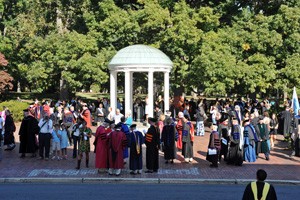About Faculty Governance
What is faculty governance?
Since the University of North Carolina opened its doors in 1795, faculty have shared responsibility with a Board of Trustees for running the campus. At UNC and many other universities, today’s system of representative “shared governance” evolved out of massive growth in higher educational institutions that took place after World War II. However, principles of shared governance and best practices for keeping the faculty voice in university policy-making strong were articulated as early as 1920, when the American Association of University Professors published its first statement on shared governance between faculty, administrators, and trustees.
Some helpful resources about both the general idea of “faculty governance” are:
- American Association of University Professors, “Governance of Colleges and Universities”
- Gary A. Olson, “Exactly What Is `Shared Governance’?” Chronicle of Higher Education, July 23, 2009
- Brian Rosenberg, “Shared or Divided Governance?” Inside Higher Ed, July 29, 2014
Faculty governance at UNC-Chapel Hill
As the first state university in the United States to open its doors (1795), the University of North Carolina at Chapel Hill has a long tradition of shared governance in which faculty play key roles in decision-making about academic matters. In the university’s early decades, a very small faculty (never more than fifteen men in the university’s first 100 years, according to articles on the website Documenting the American South on the history of faculty at the University) worked closely with either a “presiding professor” or, later, early presidents and the Board of Trustees to run the tiny campus. As former UNC history professor and Secretary of the Faculty Henry C. Boren notes in his 1993 brief history [PDF] of faculty government at UNC, the faculty’s early minutes reflect a preoccupation with two major issues: student discipline and admissions. By the 1830s, the faculty were meeting weekly with President David Lowry Swain, and for the remainder of the nineteenth century, student discipline remained a key focus of faculty activity. By the turn of the twentieth century, the University remained small, with only 23 professors, nine instructors, and a librarian.
It was not until a period of dramatic growth after World War I, which accelerated after World War II that the faculty came to a consensus that the system of formal structures were needed to codify a system of representative governance by the faculty and to define relative roles of faculty and the growing cadre of administrators who were needed to run the University. After several years of work by a faculty committee, the Faculty Code of University Government was adopted by the General Faculty in 1950. It created an elected Faculty Council to legislate on the faculty’s behalf and revised the system of faculty committees that were to report annually to the council.
According to the rules and procedures outlined in the Code as amended over the years since, and through their elected Chair of the Faculty and their representatives on the Faculty Council and the standing faculty committees, the UNC-Chapel Hill faculty has retained a strong voice as advisers to the chancellor and other administrators on the academic matters that lie at the heart of the university’s mission.
The two documents below provide a more detailed history and explanation of the development of faculty governance at UNC:
- Faculty Governance: Origins, Development, and Current Structure (2010) by Joseph S. Ferrell, Secretary of the Faculty, 1996-2016 [PPT]
- Faculty Government at Chapel Hill: The First 200 Years (A Brief History) by Henry C. Boren, Secretary of the Faculty, 1969-1984 [PDF]
For a quick overview of key information about UNC-Chapel Hill faculty governance, see our fact sheet here (08/18/2015).
Structure of faculty governance
Presentation on the overview of the structure of faculty governance at UNC-Chapel Hill from 2014 by Secretary of the Faculty Joseph S. Ferrell.
Faculty Governance at UNC-Chapel Hill.


